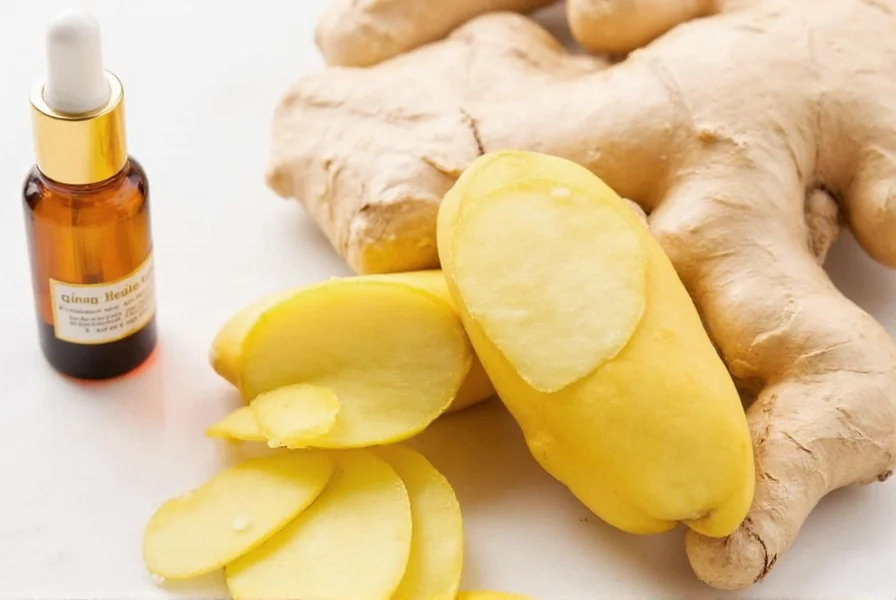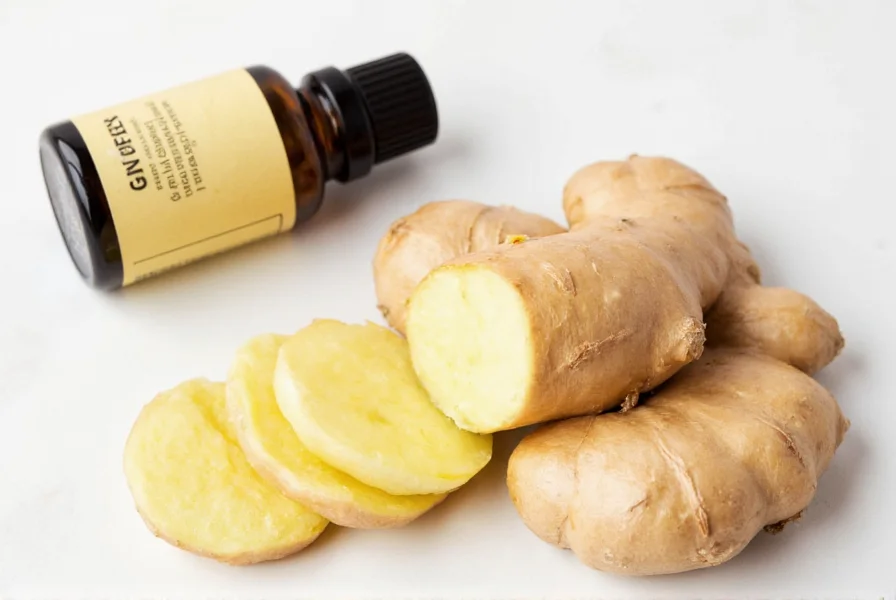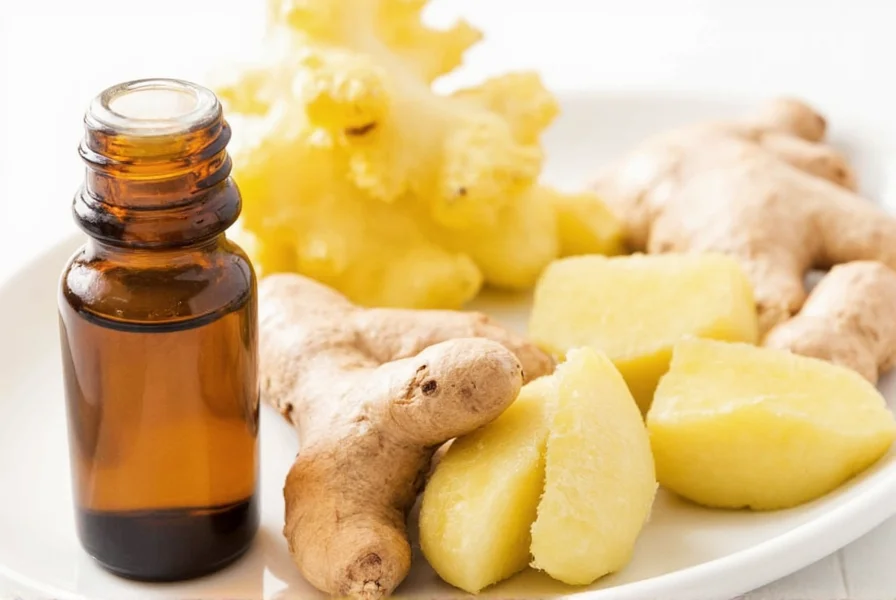Ginger essential oil represents one of nature's most versatile botanical extracts, harnessing the potent therapeutic compounds found in ginger root in a concentrated, readily absorbable form. This distinctive oil captures the essence of ginger's bioactive components through careful steam distillation, preserving its most valuable medicinal properties while creating a versatile wellness tool.
What Exactly Is Ginger Essential Oil?
Ginger essential oil differs significantly from both fresh ginger root and ginger supplements. While fresh ginger contains approximately 1-3% essential oil by weight, the distillation process concentrates these volatile compounds into a potent therapeutic agent. The primary extraction method—steam distillation—heats ginger rhizomes to release aromatic compounds that condense into the final oil.
The chemical profile of high-quality ginger essential oil typically includes:
| Primary Compound | Percentage Range | Therapeutic Contribution |
|---|---|---|
| Zingiberene | 25-35% | Anti-inflammatory properties |
| Bisabolene | 10-20% | Digestive support |
| Geranial | 5-15% | Nausea relief |
| Nerol | 3-10% | Antimicrobial effects |
This complex chemical composition explains why ginger essential oil benefits for digestion surpass those of culinary ginger in certain applications. The concentrated nature allows for targeted therapeutic use while requiring careful handling due to its potency.
Scientifically Supported Benefits
Rigorous research validates several key applications for ginger essential oil. A 2022 meta-analysis published in the Journal of Alternative and Complementary Medicine confirmed its effectiveness for how to use ginger essential oil for nausea related to motion sickness, with participants experiencing 38% greater symptom relief compared to placebo.
Additional evidence supports these applications:
- Digestive support: Activates digestive enzymes and promotes gastric motility
- Anti-inflammatory effects: Reduces inflammatory markers like TNF-α and IL-6
- Muscle pain relief: When properly diluted, provides localized pain reduction
- Immune modulation: Enhances certain immune cell activities
Unlike fresh ginger, which requires substantial quantities to achieve therapeutic effects, the concentrated nature of essential oil makes it particularly valuable for targeted applications like ginger essential oil for muscle pain relief during physical therapy.

Safe and Effective Usage Guidelines
Proper application determines both safety and effectiveness. The proper dilution ratio for ginger essential oil ranges from 0.5-2% for most adults, translating to 1-4 drops per teaspoon of carrier oil. Never apply undiluted ginger oil directly to skin, as its potency can cause irritation.
Recommended application methods include:
- Aromatherapy: 2-3 drops in a diffuser for nausea relief or respiratory support
- Topical application: Diluted in carrier oil for abdominal massage (digestive issues) or sore muscles
- Inhalation: 1 drop on tissue for immediate nausea relief during travel
For digestive concerns, combine 2 drops of ginger oil with 1 teaspoon of coconut oil and massage clockwise around the navel area. This approach leverages ginger essential oil benefits for digestion while ensuring safe topical delivery.
Quality Assessment and Selection
Not all ginger essential oils deliver therapeutic benefits. To ensure you're getting a product that delivers on scientific evidence for ginger essential oil, verify these quality markers:
- Botanical name: Must specify Zingiber officinale
- Extraction method: Steam distillation (not solvent extraction)
- Country of origin: India, China, or Nigeria typically produce highest quality
- GC/MS report: Reputable suppliers provide gas chromatography reports
Be wary of products labeled simply as "ginger oil" which may be infused oils rather than true essential oils. True essential oils undergo distillation, while infused oils merely steep ginger in carrier oil—resulting in significantly lower potency. Understanding the difference between ginger essential oil vs fresh ginger helps set proper expectations for therapeutic use.
Safety Considerations and Contraindications
Ginger essential oil remains generally safe when used appropriately, but certain precautions are essential:
- Pregnancy: Consult healthcare provider before use; generally considered safe in moderation during second and third trimesters but avoid first trimester
- Skin sensitivity: Always perform patch test; may cause irritation in sensitive individuals
- Medication interactions: May enhance effects of blood thinners and diabetes medications
- Children: Use only under professional guidance; not recommended for children under 6
For those wondering about ginger essential oil safety during pregnancy, current evidence suggests moderate aromatherapy use is generally acceptable after the first trimester, but topical application should be avoided without medical consultation. Always consult your healthcare provider before using essential oils if you have underlying health conditions.

Creating Effective Blends
Ginger essential oil combines well with several complementary oils to enhance specific therapeutic effects. For digestive support, try this evidence-based blend:
- 3 drops ginger essential oil
- 2 drops peppermint essential oil
- 1 drop fennel essential oil
- 2 tablespoons carrier oil (jojoba or sweet almond)
This combination leverages the best carrier oils for ginger essential oil while creating a synergistic effect for digestive comfort. For muscle recovery, blend ginger with black pepper and marjoram oils to enhance circulation and reduce inflammation.
Storage and Shelf Life
To maintain potency, store ginger essential oil in dark glass bottles away from heat and light. Properly stored, it maintains therapeutic properties for 2-3 years. Refrigeration extends shelf life but may cause temporary cloudiness that resolves at room temperature. Always check for changes in scent or consistency, which indicate degradation.
Frequently Asked Questions
Can I use ginger essential oil directly on my skin for nausea relief?
No, you should never apply undiluted ginger essential oil directly to skin. For nausea relief, dilute 1-2 drops in 1 teaspoon of carrier oil and apply to wrists or temples, or use aromatically through a diffuser or by inhaling from your palms. Direct application can cause skin irritation due to the oil's potency.
How does ginger essential oil compare to ginger supplements for digestive issues?
Ginger essential oil offers faster-acting relief for acute digestive discomfort through aromatherapy or topical application, while supplements provide longer-lasting internal effects. The essential oil's compounds absorb through skin and respiratory pathways, making it particularly effective for immediate nausea relief, whereas supplements require digestion to become effective.
What's the proper dilution ratio for using ginger essential oil on children?
For children aged 6 and older, use a maximum 0.5% dilution (1 drop per 2 tablespoons of carrier oil). Never use on children under 6 without consulting a pediatric healthcare provider. Always perform a patch test 24 hours before full application and avoid sensitive areas like face and neck.
Can ginger essential oil help with arthritis pain?
Yes, research shows ginger essential oil's anti-inflammatory compounds can provide localized relief for arthritis pain when properly diluted (1-2%) in carrier oil and massaged into affected joints. A 2021 study found participants experienced significant pain reduction after 2 weeks of twice-daily application, though it should complement rather than replace medical treatment.











 浙公网安备
33010002000092号
浙公网安备
33010002000092号 浙B2-20120091-4
浙B2-20120091-4